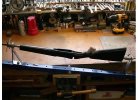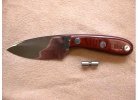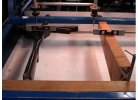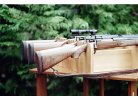Micarta for a gun stock? Naw. I have around 500 pounds of the stuff.
Makes nice knife handles. Too heavy for a gun stock. Breathing the fumes when working Micarta is deadly. When I toyed with knives I ground the handles under a water spray to knock down the nasty dust.
Back to gunstocks.
I do it this way:
Make a pattern out of hardwood. Tweak the LOP, pitch, drop, grip shape & size, etc, all the essentials. Stick the barreled acion in the pattern. Go out and shoot the gun. Repeat the tweaking until you get it right. Then head to a shop with a duplicator, give them the pattern and wait.
Pattern work shown below. Note the cut in the grip for cast off.
Working on the pistol grip. Final edition not as long as shown.
In my duplicator for the final rendition.
I have methods for determining drop, pitch, cast off and a few other numbers. It is not an exact science and takes some trial and error. This is why the traditional gun builders such as Holland & Holland have adjustable try stocks.
Back to that 3 piece laminated walnut stock: Pioneered by Mel Smart, Accubond stocks. Kilimanjaro now owns the rights.
The front stock in the photo below is an original Mel Smart stock, the rifle is iron sights only. Note the drop at comb and heel and the pitch of the butt as compared to the two M70 factory stocks behind it. This rifle has 3/8" cast off. 458 Lott in Mel's stock. Other rifles are a 458 Win Mag and a 416 Rem.
I am not a stock maker for hire, I just play with my personal rifles. One thing I have learned over the past 5 years or so is most American gun builders have no idea of proper stock fitting for iron sights. That drop and cast off makes for easy use of the iron sights! My dimensions after some years of trial and error are as follows: LOP 14-1/2" Drop at comb 5/8" Drop at heel 1-1/2" Toe out 1/4" Cast off 3/8" Pitch 2 to 2-1/2 ". Hmm. I have three pre WWII Mauser stocks, two from England and one from Germany. From Iron sighted rifles. The dimensions are not far from my own.






